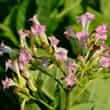Background
- Tree tobacco (Nicotiana glauca) comes from Argentina, Paraguay, and Bolivia and is now a common plant in California. Tree tobacco should not be confused with smoking tobacco (Nicotiana tabacum). It is on the list of toxic plants in several states, including Texas, California, and North Carolina. Native Americans in some areas substitute it for native tobacco. To enhance the spiritual experience, tree tobacco is sometimes smoked by California Native Americans in combination with Datura wrightii, which may be dangerous as both plants induce respiratory depression.
- Tree tobacco has been publicized as a safe, hallucinogenic plant on some internet websites. However, smoking or ingesting the plant has lead to death.
- There is insufficient evidence in humans to support the use of tree tobacco for any indication.
References
- Backheet EY, Sayed HM. Two new chlorinated amides from Nicotiana glauca R. Graham. Pharmazie 2002;57(3):206-208.
View Abstract - Janakat S, Al Merie H. Evaluation of hepatoprotective effect of Pistacia lentiscus, Phillyrea latifolia and Nicotiana glauca. J Ethnopharmacol. 2002;83(1-2):135-138.
View Abstract - Lee ST, Wildeboer K, Panter KE, et al. Relative toxicities and neuromuscular nicotinic receptor agonistic potencies of anabasine enantiomers and anabaseine. Neurotoxicol.Teratol. 2006;28(2):220-228.
View Abstract - Maier W, Schmidt J, Nimtz M, et al. Secondary products in mycorrhizal roots of tobacco and tomato. Phytochemistry 2000;54(5):473-479.
View Abstract - Mellick LB, Makowski T, Mellick GA, et al. Neuromuscular blockade after ingestion of tree tobacco (Nicotiana glauca). Ann Emerg.Med 1999;34(1):101-104.
View Abstract - Mizrachi N, Levy S, Goren ZQ. Fatal poisoning from Nicotiana glauca leaves: identification of anabasine by gas-chromatography/mass spectrometry. J Forensic Sci 2000;45(3):736-741.
View Abstract - Panter KE, Weinzweig J, Gardner DR, et al. Comparison of cleft palate induction by Nicotiana glauca in goats and sheep. Teratology 2000;61(3):203-210.
View Abstract - Plumlee KH, Holstege DM, Blanchard PC, et al. Nicotiana glauca toxicosis of cattle. J Vet.Diagn.Invest 1993;5(3):498-499.
View Abstract - Sims DN, James R, Christensen T. Another death due to ingestion of Nicotiana glauca. J Forensic Sci 1999;44(2):447-449.
View Abstract - Skliar M, Curino A, Milanesi L, et al. Nicotiana glauca: another plant species containing vitamin D(3) metabolites. PLANT SCIENCE 7-28-2000;156(2):193-199.
View Abstract - Steenkamp PA, van Heerden FR, van Wyk BE. Accidental fatal poisoning by Nicotiana glauca: identification of anabasine by high performance liquid chromatography/photodiode array/mass spectrometry. Forensic Sci Int 7-17-2002;127(3):208-217.
View Abstract - Waka M, Hopkins RJ, Curtis C. Ethnobotanical survey and testing of plants traditionally used against hematophagous insects in Eritrea. J Ethnopharmacol. 2004;95(1):95-101.
View Abstract - Weinzweig J, Panter KE, Pantaloni M, et al. The fetal cleft palate: I. Characterization of a congenital model. Plast.Reconstr.Surg 1999;103(2):419-428.
View Abstract - Weinzweig J, Panter KE, Pantaloni M, et al. The fetal cleft palate: II. Scarless healing after in utero repair of a congenital model. Plast.Reconstr.Surg 1999;104(5):1356-1364.
View Abstract - Weinzweig J, Panter KE, Spangenberger A, et al. The fetal cleft palate: III. Ultrastructural and functional analysis of palatal development following in utero repair of the congenital model. Plast.Reconstr.Surg 2002;109(7):2355-2362.
View Abstract







